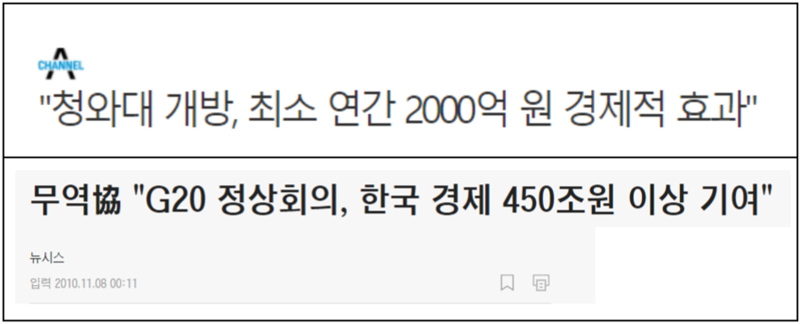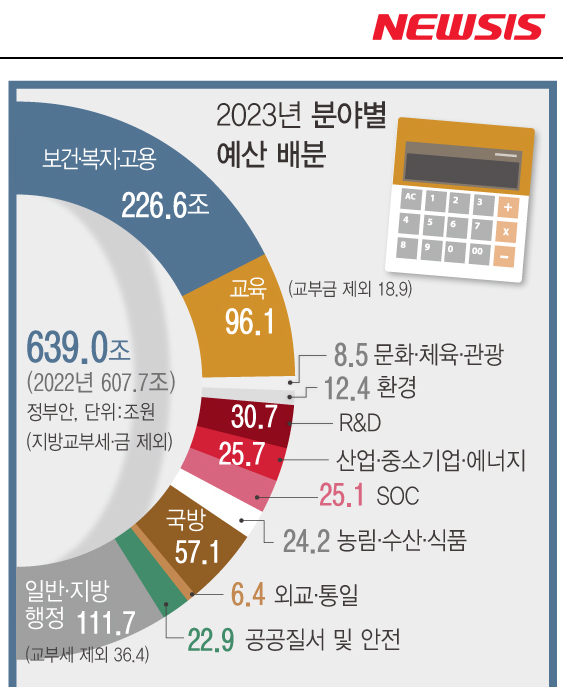–
There was a report that the opening of the Blue House would have an economic effect of 200 billion won per year. The economic effect of the Pyeongchang Winter Olympics was also said to be 65 trillion wins. However, the most memorable economic effect was the report that the economic effect of the 2010 G20 summit was 450 trillion won. When all of these economic effects are added up, Korea’s GDP easily surpasses.
 –
––
Miracles like this happen more often than you think.
This is a budget report for next year. The budget for next year is 639 trillion won. Of these, 226.6 trillion won are spent on health care and welfare employment. 96.1 trillion won is spent on education and 8.5 trillion won on culture, sports and tourism. Add up all the numbers on this chart. Amazingly, that’s 647 trillion won. Total spending next year will far exceed KRW 639 trillion. In particular, 5.2 trillion won in reserve funds and 9 trillion won in the telecommunications sector are also excluded.
 –
––
It is not the fault of the media. Because the government publishes statistics this way. The amount of expenditure by sector in the press release of the government budget proposal has some overlapping items and some excluded items. The basics of statistics themselves are not. After all, if the budget exceeds 639 trillion won, it would be good to spend more (?) While you spend it. Add 50 trillion won to the low fertility budget and 30 trillion won to the jobs budget. Or, as President Yun Seok-yeol said, let’s include 33 trillion won in the gender budget.
It is well known that the 33 trillion won in the gender budget is not additional money spent on gender awareness. It refers to the size of the budget which evaluates the existing budget from a gender perspective. The classification of the low fertility budget and the labor budget is similar. 30 trillion won is not the only amount spent separately on the jobs. It refers to the amount that has been classified for the purposes of low fertility and labor management for existing businesses. In that sense, it cannot be included in the 639 trillion won distribution. Likewise, the research and development budget of 30.7 trillion won is an area that is counted as a duplicate. It is the main reason why more than 100% of the magic occurs in the sum of 30.7 trillion won superimposed on welfare research and development projects and national defense research and development projects.
Of course, the 21st century Republic of Korea does not administer administration through such an unscientific budget classification system. All budget projects in Korea have a clear classification system and are classified and managed through accurate code numbers. The problem is that the budget press releases of the Ministry of Strategy and Finance are classified and explained according to the arbitrary practice of the Ministry of Strategy and Finance, rather than this classification system. Budget experts are also analyzing budgets through the government’s official ranking system. Even experts cannot verify the press release of the budget proposal of the Ministry of Finance. It is not a realm of analysis and verification, but a realm of belief.
Likewise, the government reported that it achieved the largest spending restructuring ever through a 23-year budget press release. In the past, it was at the level of 10 trillion winners, but this time it boasts a whopping 24 trillion winners. However, this is also a realm of belief, not of verification. The government does not disclose the list of restructuring expenses of 24 trillion won.
In particular, what I want to talk about today are the 74.4 trillion won in “four fundamental tasks for the socially disadvantaged in 23 years”. According to the government, a total of 74.4 trillion won is spent, including 21 trillion for the low-income class, 5.8 trillion for the disabled, 24.1 trillion for vulnerable young people and 23.3 trillion for the elderly. children and youth. However, the detailed list of projects worth 74.4 trillion won is not available. This is not the realm of verification, but the realm of belief.
Again, there is a consolidated balance sheet classification system in Korea. The welfare sector is classified and managed by dividing it into security of basic livelihoods, support for the most vulnerable and the elderly. An explanation according to this formal classification system should be the basis. Of course, in addition to the official classification system, the concept of low fertility budget, a budget for work, a budget for research and development and a budget for the disabled are also needed for specific purposes. In such a case, the detailed list of companies corresponding to this new classification method should be disclosed via an attached sheet. Otherwise, a total of more than 100% of the magic will happen constantly. The key to budgetary spending is the allocation of resources with limited budgetary constraints. When spending in one sector or sector increases, spending in another sector and sector naturally decreases. In this situation, if the distribution of total spending of 639 trillion won in Korea is not classified and analyzed using the same criteria, but explained through each criterion, there is no practical advantage in the budget analysis.
When a government press release is released that cannot be verified, reporters are more upset. However, it is impossible not to report a major announcement from the government at all. However, it is scary to write an article summarizing the release without any evaluation or interpretation. So how about writing an article with exact limits?
※ Media Today we appreciate your relationships. news@mediatoday.co.kr
–
![[이상민의 경제기사비평] The reason why magic happens that exceeds 100% of the budget [이상민의 경제기사비평] The reason why magic happens that exceeds 100% of the budget](https://cdn.mediatoday.co.kr/news/thumbnail/202209/305796_417427_5414_v150.jpg)

